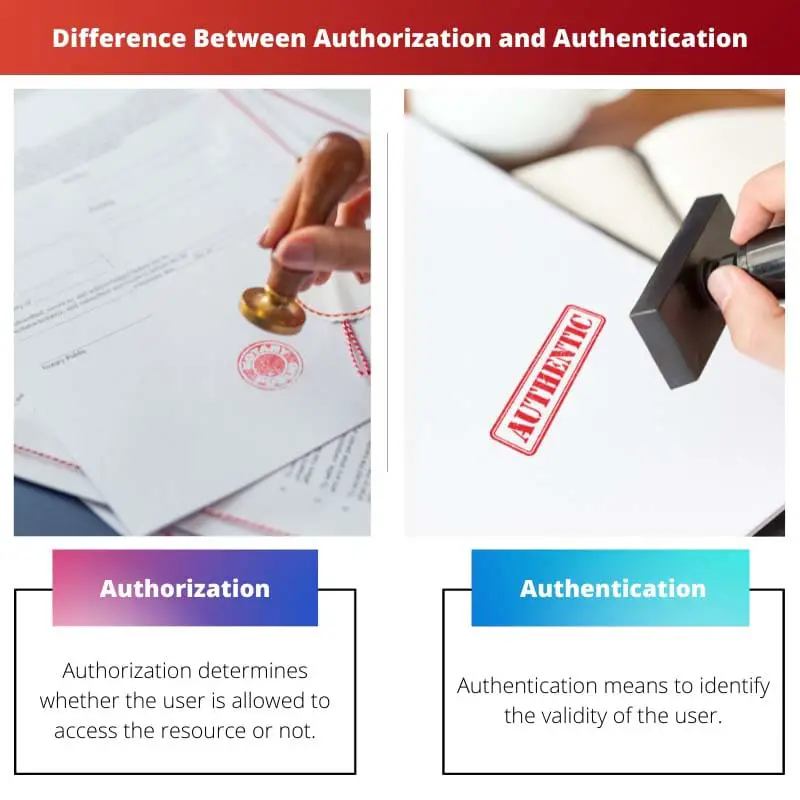Authorization is defined as granting official permission or approval. This word was first coined in between 1600-10.
The word ‘authorization’ is derived from the word ‘authorize’. The word ‘authorize’ originated from two medieval Latin words ‘auctor’ and ‘auctorizare’, an old French word ‘autoriser’ and the English word ‘author’.
The root word of ‘authorization’ is ‘authorize’. ‘Authorize’ originates from a Latin word ‘auctor’, it means ‘the one who causes’.
Authentication is defined as a process to prove something to be genuine. The word ‘authentication’ is derived from the word ‘authenticate’.
The word ‘authenticate’ is derived from the ancient Greek word ‘authentikos’ and late Latin word ‘authenticus’. The word ‘authentication’ was first coined in the 1650s.
Key Takeaways
- Authentication is verifying a user’s identity, through credentials such as a username and password, ensuring that the user is who they claim to be.
- Authorization grants or denies access to specific resources or actions based on a user’s authenticated identity and assigned permissions or roles.
- Both authentication and authorization are essential components of secure systems, with authentication establishing a user’s identity and authorization determining what that user is allowed to access or perform.
Authorization vs Authentication
The difference between authentication and authorization are by definition, the approach of action, priority order, the process and the usage. These words are misunderstood as synonyms. But they have different meanings in the technical world. These parameters are used for better understanding of both the words and rightful usage.

Let’s understand the use of the word ‘authorization’. Authorization means to permit to do a certain job.
For example, ‘Prince George handed them a signed authorization to enquire’. The sentence means that Prince George has permitted to enquire.
Generally, authorization has legal importance. Now let’s understand the use of the word ‘authentication’.
Authentication is a process to prove a certain entity as valid. For example, ‘access to the system requires authentication’.
The sentence means that participants enrolling to use the system need to verify their identities.
Comparison Table
| Parameters of Comparison | Authorization | Authentication |
|---|---|---|
| Definition | Authorization determines whether the user is allowed to access the resource or not | Authentication means to identify the validity of the user |
| Approach | It determines whether the user has permission to access the resource or not | It determines whether the user is the same as he or she claims to be |
| Priority | Authorization is always the top-most priority | Authentication always comes after a successful authorization |
| Process | The process of authorization is to check the eligibility of the user to access the system | The process of authentication is to verify the claims of the user |
| Usage | The word is used mostly in the technical and legal field | The word is used mostly in the technical and legal field |
| Example | The owner of the company has the authorization to use our data for security purpose. | Joe got rejected because he failed the authentication process. |
What is Authorization?
Authorization is a security mechanism that decides whether or not to permit to further access the system. The system may be a file, a database, a service, a computer application, a computer software.
The first step to the web security system is authentication. This steps either grant or deny permission to the user.
Only if this step is successful, the user can further use the system. There are four major types of authorization in API.
- API Key
- Basic Auth
- HMAC (Hash-based Message Authorization Code)
- OAuth
Hash-based Message Authorization Code(HMAC) is highly advanced. HMAC uses a secret key which is known only to the user and the server.
There are two types of OAuth.
- One-legged OAuth
- Two-legged OAuth
One-legged OAuth is used when the data is not very sensitive. This can be used when it is not very important to secure the data.
This is used in case of read-only information. Three-legged OAuth is used when the data is very sensitive.
This is used when it is extremely important to secure the data. Three groups that are participating in such an authorization type are:
- The authentication server
- The resource server (API server)
- The user or app

What is Authentication?
Authorization is the process that verifies the claims made by the user about their identity. It works towards securing the system.
Authentication comes in action only after successful completion of authorization. Application Program Interface(API) is a set of certain rules and protocol to be followed to design any software application.
Authentication is used to secure a modern and advanced system. They are used to avoid any illegal use of data.
There are five major types of authentication.
- Password-based Authentication
- Multi-factor Authentication
- Token-based Authentication
- Certificate-based Authentication
- Biometric Authentication
Biometric authentication is further categorized as:
- Facial Recognition
- Voice Identifier
- Eye Scanner
- Fingerprint Scanner
Authentication is a way to ensure the security of the system and the user’s data. Its objective is to keep the system secure and private.
Hackers always find a new way to enter into system and leak information. So, the basis of authentication needs to improve with time.
A good authentication system is key to build an effective and long-lasting application software. Biometric authentication is the latest and most reliable type of authentication.
Amongst different type of biometric authentication, a fingerprint scanner is the most widely used.

Main Differences Between Authorization and Authentication
- Authorization is the process of specifying rights related to a certain system. Authentication is a process involving the verification of the user.
- Authorization validates privileges of the user but authentications verify its credentials.
- The authorization has priority over authentication.
- Authorization asks what permission does the user have in order to access the system. Authentication verifies whether the user is rightful or not.
- Authorization checks the role of the user and right to access. Authentication requires username and password.

- https://ieeexplore.ieee.org/abstract/document/4151773/
- https://www.nics.uma.es/sites/default/files/papers/JavierLopez2004.pdf

The explanation of different types of authorization, such as API Key, Basic Auth, HMAC, and OAuth, provides a comprehensive overview of the topic.
The clear explanation of One-legged and Three-legged OAuth in the context of sensitive data is insightful and valuable for understanding secure systems.
The historical context provided on the origins of the words ‘authorization’ and ‘authentication’ is fascinating, adding a unique dimension to the discussion of these concepts.
Absolutely, delving into the etymology of technical terms enhances our understanding of their meaning and relevance in modern contexts.
I disagree with the statement that ‘Authentication always comes after a successful authorization’. This is not always the case, especially in certain secure systems.
The comparison table is an excellent way to highlight the differences between authorization and authentication, making it easier to comprehend.
The explanation of Biometric authentication as a subcategory of authentication adds depth to the understanding of modern security measures.
I appreciate the historical perspective provided on the origins of the words ‘authorization’ and ‘authentication’. It enriches the understanding of these concepts.
Absolutely, understanding the etymology of these terms helps us appreciate their significance in modern contexts.
Great explanation of the difference between authorization and authentication. It is important to understand the distinction between the two in order to develop secure systems.
The emphasis on the importance of understanding the differences between authorization and authentication is crucial for implementing secure systems.
The detailed overview of the types of authentication, including Password-based, Multi-factor, Token-based, and Biometric, is highly informative.